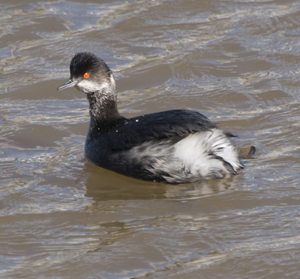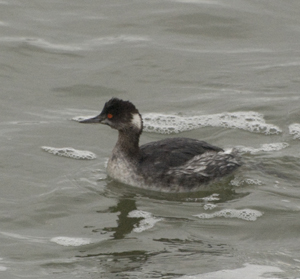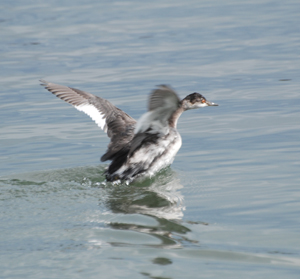Eared Grebe
Order: Podicipediformes
Family: Podicipedidae
Genus:Podiceps
Species:nigricollis
Description
- Length: 13"
- Wing Span: 16"
- Weight: 11oz (300g)
- Description: Red eye very distinctive. Smallest of the Grebe family. Non-breeding: small black & white water duck. Head, face, neck and back mostly black. In-distinct white patches on face and chest. Often shows a high rounded back with black and whit'ish flanks. Breeding: Black, head, face, neck and back. Yellow whispy plumes on face. Dark body in general. Peak or hump in the head formation is usually visiable above the eye.
- Gender Differences: Male & Females alike. Juveniles resemble non-breeding adult except with more brown on the back and neck.
Factoids:
- The most abundant grebe in the world, the Eared Grebe breeds in shallow wetlands in western North America. It occurs in greatest numbers on Mono Lake and the Great Salt Lake in fall, where it doubles its weight in preparation for a nonstop flight to its wintering grounds in the southwestern United States and Mexico
- At its fall staging areas, the Eared Grebe more than doubles its weight. The pectoral (chest) muscles shrink to the point of flightlessness, the digestive organs grow significantly, and great fat deposits accumulate. Then before departure for migration, the digestive organs shrink back to about one-fourth their peak size and the heart and pectoral muscles grow quickly.
- A cycle similar to that of the fall staging areas occurs three to six times each year for the Eared Grebe. For perhaps nine to ten months each year the species is flightless; this is the longest flightless period of any bird in the world capable of flight at all.
- The Eared Grebe migrates only at night. Because of the length of its fall staging, its southward fall migration is the latest of any bird species in North America.
- On cold, sunny mornings, the Eared Grebe, like some other grebe species, sunbathes by facing away from the sun and raising its rump, exposing dark underlying skin to light. This behavior may make the bird appear to have a distinctive "high-stern" profile.
- Simlar species include: Horned Grebe
- see table below for major differences
-
Eared Horned bill color darker gray Gray'ish with a white tip back
high and rounded low & slightly rounded head, face & neck features mostly dark with small white patch behind the cheek Black cap, white face, neck & chest
All photo, video and audio on this site are ©2010 Jamie Osterbuhr
Life List Index #83, November 4th, 2006 - California
Sources: Cornell Lab of Ornithology, The Sibley's Guide to Birds, Sibley's Birding Bascis, The Sibley's Guide to Bird Life & Behavior
 |
|---|
 |
 |
 |
 |
